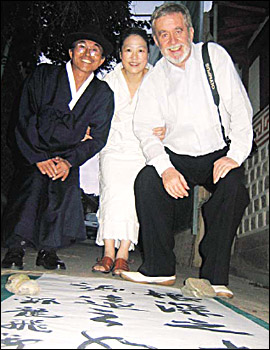
David Kilburn, right, his wife Jade, and Metta Kang in Korean costume used during rituals, survey scroll of remarks celebrating hanoks, Korea’s traditional homes. / Korea Times Photo by Tony MacGregor
By Tony MacGregor
Korea Times, September 20th 2006, p16
The struggle of a 62-year-old Englishman and his Korean wife to save a district of traditional homes took a step forward on Sunday.
 |
David Kilburn, right, his wife Jade, and Metta Kang in Korean costume used during rituals, survey scroll of remarks celebrating hanoks, Korea’s traditional homes. / Korea Times Photo by Tony MacGregor |
About 35 foreigners, Korean supporters and artists, including two classified as intangible cultural assets, gathered at the ``hanok,’’ a traditional Korean home, of David Kilburn and his wife Jade to celebrate thousands of years of Korean culture and invoke spiritual help to preserve the hanoks of Kahoe-Dong in a four-hour festival.
For over three years now the couple has been leading a struggle to save the hanoks which, they say, are under threat by government policies and land speculators.
"We haven’t seen any change in policy since the new metropolitan government took over,’’ said Kilburn, a tea merchant and former journalist. "We had been led to believe we would meet with the new mayor but that meeting has never taken place. We have met several times with officials, but nothing really came of those meetings. The hanoks are still in danger.’’
He said the government program that provided low-interest loans for hanok-owners to rebuild their homes (and destroy the original hanok says Kilburn) has run out. "But we are still not sure that government-funds are not being used to destroy hanoks,’’ he said.
He said the purpose of the meeting on Sunday evening was to combine the creative power of artists with an appeal to the spirits and gods to preserve the buildings.
Poet Lee Chun-woo, wrote and recited a special poem for the occasion while Lee Jang-hak sang Korean folk songs. A Korean flute (taegum) recital was given by Kang Sung-se, and Park Jong-soon also recited Korean poems, including one written by her especially for the occasion.
While professors Song Hyung-ik (chairman of the Korea Guitar and Art Academy) played his guitar, Mrs. Lee Ki-sun danced spirit dances. A group of five musicians played samulnori music.
At the end of the evening, guests and artists spilled out on the street in front of the Kilburn’s hanok while calligraphy professor Kwon Sang-ho helped them write poems or prose about the homes on a paper scroll that stretched down the center of the street. Two of the English-language remarks read, ``Hanoks, the DNA of Korean history,’’ and ``The beauty of the hanok shines through obscurity.’’
For more information about Kilburn's campaign to save the traditional houses, visit his Web site at www.kahoidong.com.